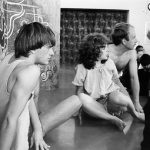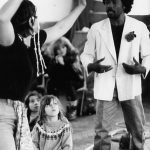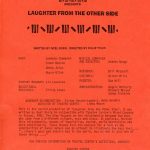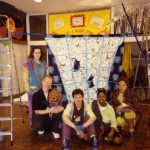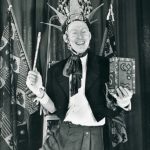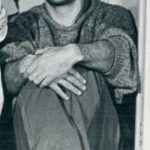In early 1976, David Johnston, co-founder of Perspectives Theatre Company, persuaded the Arts Council to give him an actor’s grant (in those days they used to give grants for skills development) to go and visit all the TIE companies around the country to see what they were doing. He was very interested in seeing Theatre Centre because on the one hand it was the biggest company in the country, on the other hand it was considered old-fashioned.
David Johnston recalls:
‘When I joined Theatre Centre the actors were nearly all people straight from drama school getting Equity cards. They’d rehearse two shows 50 minutes long within two weeks, then tour them for 10 weeks, four shows a day; they’d often do two schools a day, 10 schools a week. I joined as Brian Way’s successor – his job was advertised in July 1976. I’d visited him and seen the shows and thought why not? I didn’t expect to get an interview but I was interviewed twice in August and Brian rang me and suggested I work with him for a couple of weeks and see how it goes, so I turned up there and shadowed Brian and got the job. I worked as joint Artistic Director with Brian for six months from October 1976 to April 1977 when he officially left. It was Brian’s baby for 25 years and the letting go process is very difficult but he went away and left me to get on with it and then he came back in the autumn to see what we’d done with the show. For the first year I found a script of Brian’s that I liked – Mr Grump and the Clown – which we put out for small children in his standard way, and I commissioned a new play by Brian Hales who was writing for the Unicorn and for Dr Who which had a science fiction feel but was about Victorian times, about youth, and we did A Taste of Honey for secondary schools which was an established standard at that time. Brian came back to see the shows at the end of the first term – he didn’t like my production and we had a row and I said I had to change things and move the material forward because that’s what people want and need – they want more of the TIE content but I will try and keep the form, the intention and the passion and the basic core function of the company which is national touring and children are the priority. Brian didn’t come back to see another show for three or four years after that.’
Early days
‘We were in West End Lane – in a corner shop which had two floors. We rehearsed in churches and community halls around Harlesden. We had two offices in the shop and the vans were kept on the road, everything was done really leanly to get as much work out to children. It was very rare actors stayed more than a term because they were too exhausted, they were on Equity minimum.
‘The first three years I was trying to ensure that the funding continued, that the local authority saw we were building in the TIE sensibility and that I could consolidate a team of people to work with me who would stay for a length of time and be the best people we could find. The first thing we changed was the work – moving towards more thematic work – we brought in writers I’d worked with before, ex-TIE people – to use the Brian Way model to do more issue-based work. I started writing infant shows for about three years and we’d use the form of four actors – I did one about robots in 100 years time taking over the world, a version of The Pied Piper with Maggie Thatcher as the Mayor. We transposed the form and we brought in new writers: the Arts Council had a very good new writers scheme at that time – if you wanted a writer for six months they would pay for them. We brought in people like Charles Way but the significant turning point was when I brought in David Holman who joined us as resident writer in 1978, a superb writer. He was able to start writing most of our top primary and secondary shows. The first one he did was called Plague 78 which was about pollution. I continued writing the infant plays and we worked together for some time. From 1979-1982 David wrote most of our plays and we developed a house style. We brought in new directors – Roger Watkins stayed – we were joined by Geoff Bullen and we built up a really good team and moved the work to become less participatory – still inclusive, still mainly in the round, but much more hard-hitting. David wrote a play in 1979 about Argentina – a very powerful piece of work about fascism [in which a history teacher and one of his students are arrested for allegedly helping another teacher escape from a detention camp] – which was the first time we were seen by the TIE companies as having a clear political purpose, attempting to open up the real world to people – we did a whole year of Third World themes. We did a play called Inuit – we brought in a fantastic anthropologist called Hugh Brody who worked with us on that.
‘By 1981 the work had become young people’s theatre as the best TIE teams were doing it at that time – naturalistic, about young people and seeing the world from young people’s eyes, a contact character that you followed and empathised with, conflict, going on journeys, solving problems. David Holman’s Drink the Mercury, written in 1982 [about the tragedy of the small Japanese fishing village of Minamata whose main food supply is poisoned with mercury by a local chemical factory] is a story of people with a problem who go on a journey to try and solve the problem. We worked out there were about two or three classic structures that Brian had – one was The Wizard of Oz – people get together to go on a journey and face conflicts, another was a competition where people compete to solve a problem.
‘That was going on on the artistic side, on the other side there were massive problems to start with. A lot of the best companies had equal wage policies at that time. I wanted to introduce an equal wage policy but at Theatre Centre the director and administrator were paid about three times as much as everyone else and the actors were on minimum. I tried to solve that as quickly as possible. I realised that not only were ILEA planning to cut the company’s money but also at that time in the late 1970s there was a lot of growing money for this sort of work in local authorities, including London. There was Inner City Partnerships money – three-year plans where you could get £100,000 a year for new projects. So we set up a relationship with Islington, with the Director of Education – he gave us a school building to rehearse in and he backed us for this Inner City Partnership so in addition to the Arts Council money and local authorities money we suddenly got this extra lump of money. We amalgamated the money and myself and the administrator halved our wages and we equalised everyone’s wages. We started doing three shows a day, then we cut the length of tours, then we went down to two shows a day. We increased the rehearsal time and we had new writing coming in. So the job became similar to a TIE team where you’d rehearse the show for four weeks, tour it for four weeks, have a half term holiday, tour for another five weeks, have a three-week paid holiday. So then people started to stay. We had a lot of friends, colleagues from the other companies who were getting very interested in our work by then so over the first three years we built up a permanent company.’
Controversy and diversity
‘By the early 1980s, Theatre Centre had links with other companies that were growing up in London at that time – Women’s Theatre Group, Oval House, Gay Sweatshop, Belt and Braces, Monstrous Regiment. They were doing more workshops, follow ups, more in-depth work like TIE were doing, not just productions, also more work abroad – exchanges and visits – such as Canada, Australia, Cyprus and Malta. Extra funding from Islington led to a commitment to producing more work in Islington. In 1982 they were given a large space for free in Hanover School, Noel Road, Islington – a perfect set-up with office space, rehearsal space, design space and the opportunity to work with the school and teachers.’
David recalls that most of the plays were about working class kids, whereas Brian Way’s plays had been all about Kings and Queens and wizards. Most of the company were from university or drama school backgrounds but in the late 1970s/early 1980s the drama schools had much larger numbers of working class kids because the local authorities gave full grants to talented working class kids.
After David Johnston had been away working in Hong Kong for six months, he set up Festival of Peace – a year’s peace project in 1982 which was massively successful and very controversial. The company toured six new shows round schools and theatres, got extra funding from the GLC (under Ken Livingstone) and raised their profile – with David Holman’s very successful plays Peacemaker, Susumu’s Story and 1983 (about cruise missiles) they became more focused and political, producing more issue-based work. Norman Tebbit tried to get Holman’s plays banned in Waltham Forest and put out a bulletin that made the national newspaper headlines trying to persuade parents to stop their children seeing the plays. The Press supported Theatre Centre, however, and local authorities and the Arts Council backed them to the hilt so the government had to re-trench.
In the late 1970s/early 1980s the company’s productions were addressing a range of themes such as disability and racism, including Geoff Bullen’s Chairperson, Bunkers by Jamal Ali and Lisa Evans’ Under Exposure. Theatre Centre employed black writers and directors and Gwenda Hughes suggested starting up an all-women’s company with productions being written, acted, designed and directed by women. By the mid 1980s about half the company were gay or lesbian and people suggested they should have a company that was consciously mixed – men, women, gay, straight. In 1985 they started working with Graeae and brought in disabled actors. Nona Shepphard and Bryony Lavery worked for Theatre Centre and Theatre Centre’s Women’s company. Productions include: Zulu Hut Club (1984), The Mrs Docherties – performed at the Drill Hall, London in 1985, Getting Through (1985), Over and Out (1985) and Two Marias (1988). Nona wrote and directed anti-racist, anti-apartheid shows and she also did a lot of work with Monstrous Regiment, Women’s Theatre Group, Gay Sweatshop, Quicksilver, M6, Roundabout and New Perspectives, and did many shows at London’s Drill Hall including writing and directing their five legendary all-women pantos (writing two with Bryony Lavery) as well as In The Parlour With The Ladies and In The Bunker With The Ladies. In 1984 David Holman wrote Frankie’s Friends – set on a council estate playground with a gang, a bully, a foreign girl and a refugee boy – the set was a range of parallel bars, designed by Bill Mitchell (who joined Theatre Centre in 1982), actors had to be trained by a gym teacher and everyone was on roller skates.
The company were operating with 20-odd people pretty collectively and it had a lot of very strong personalities. In 1986 Noel Greig joined and they produced a series of shows about sexuality awareness. Noel wrote a junior show Laughter from the Other Side about an Asian boy who was in love with a white boy. In the mid-80s, in the middle of Thatcherism, the arts community and the Left were under attack – Noel describes this as a ‘key moment’ when it was ‘all ghastly’ and many artists found work with young people as a way of being ‘able to carry on with our work at a time when that work was under attack through being invisible, with no status, not taken much notice of’ – outside main arenas. ‘I really liked writing plays for those audiences, taking plays into schools. During that period I developed that role into creating a platform for developing new writers’ work.’ He worked with commissioned writers like Lin Coghlan and Jackie Kay and had a writers group for those who hadn’t written before like Roy Williams. Roy had played Queen Victoria in Noel’s play Familiar Feelings. The first play Roy did for the company was by Lin Coghlan when he played a Roman soldier. David Johnston sums up what was so special about Noel Greig and his writing for young people: ‘his sheer poetical skill and great facility with language, his passion, humour, a deep understanding of the human condition and how best to explore and reveal it in all its facets, both personally, emotionally, and politically and, above all, a deep compassion for his fellow humans which springs off the page and will continue to enter our hearts and sometimes take our breath away’.
‘The ethos and the style of the company was very much of that period…it was run collectively…it was very volatile…from the outside it would have looked shambolic to the bureaucracy but it worked…lots of fierce debate…very vibrant…the politics had not been lost. It was very attractive to those of us who’d been involved in all those other companies to discover this company that was taking work to young people, who were absolutely defiantly operating as a cultural resistance. Theatre Centre was at the forefront of that. It was a company that was strenuously inviting the development of a broad spectrum of artists from different areas of the community. If we can find the themes, the stories, that key into some part of a young person’s life, the way is clear for us to weave into the fabric of the work all those things which we know must be opened up if we know we are to have a better world.’ The company was sending progressive and subversive work into schools and creating a company where a whole range of voices were being developed in work as actors, designers, writers, forging ahead with a representative range of artists that reflected the society they were living in.
Moving on
By early 1986 David decided he was exhausted and needed a break and gave a year’s notice. He said it all came to a big crunch six months later with Jackie Kay’s first play Twice Over for the Women’s company which half the women thought was racist, half the company thought was sexist, a lot of the gay white members thought it was really important to do it, a lot of the straight black men thought they really shouldn’t do it and the company stopped for a week to sort it all out and in the end they never did the show. The play was about a [white] woman coming out of her coffin and telling her story [to her mixed heritage granddaughter] about how she was a lesbian but had never come out. It would have been controversial in schools at that time of Clause 28. The company had built up integrated casting for about five years and deliberately created a situation where everyone could be any race, any gender. David felt it reached a point where emotions were clouding logic and, after many meetings, two people resigned. The play was produced a couple of years later by Nona [Shepphard] for Gay Sweatshop at the Drill Hall.
David sums up his time at Theatre Centre:
‘You worked with writing, developing new projects like the integrated companies, working with disabled artists, developing black artists, keeping an equal wage policy going for 10 years, trying to do the very best we can to move the work forward artistically and educationally but also to be inclusive and not to be didactic.’
David went on to run a number of children’s theatre festivals, became Director of Roundabout in Nottingham and set up a diploma course linked with RADA. He founded Tangere Arts in 2003 with his partner Ava Hunt – with Arts Council funding – to do young people’s workshops and shows in the Derbyshire/Nottinghamshire area – including Noel’s play Hood in the Wood which toured around schools for six months and came to Theatre Centre in 2006.

